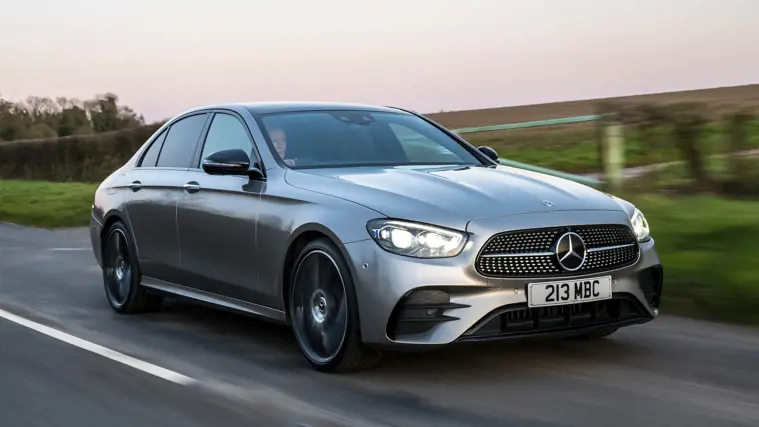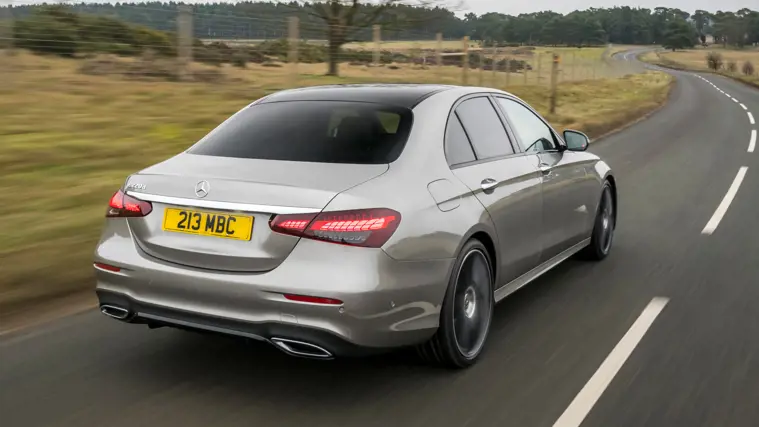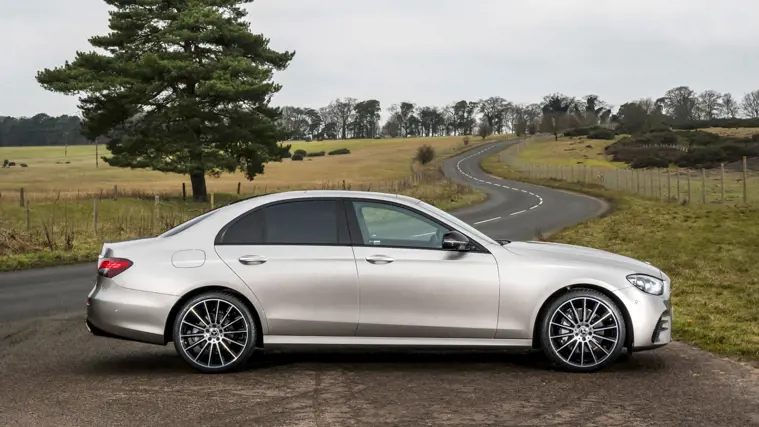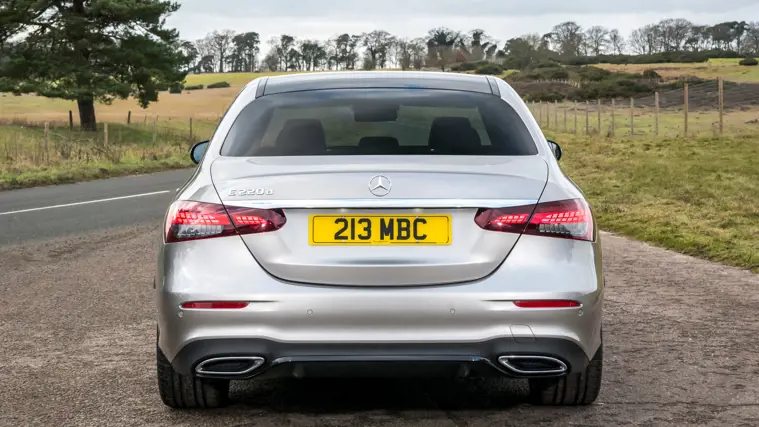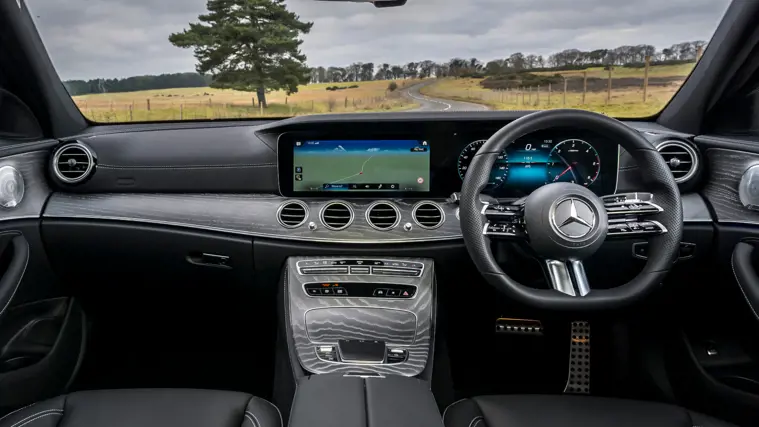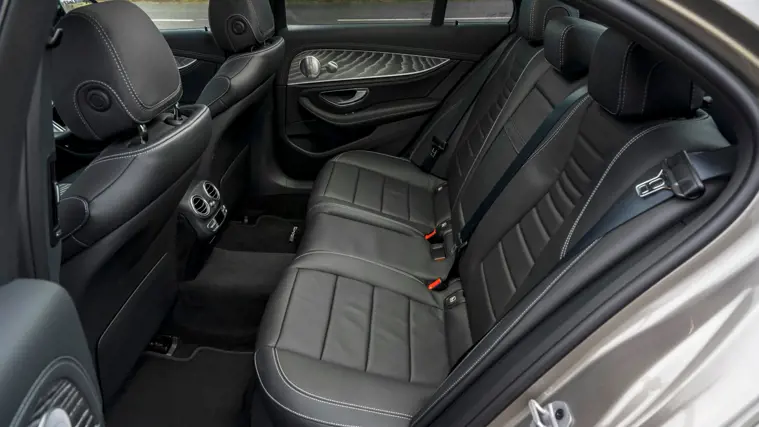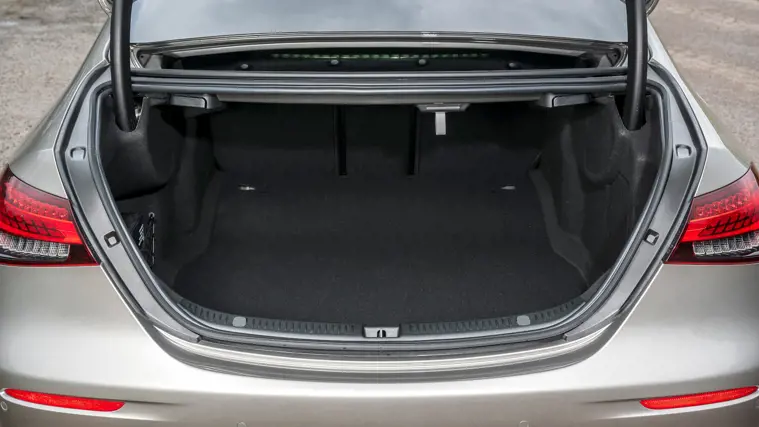Mercedes E-Class Review
Still the leading luxury family car, the Mercedes E-Class also offers the latest tech - at a price
Strengths & weaknesses
- Extremely comfortable ride
- Hi-tech options
- Spacious interior and boot
- Expensive, especially when options are added
- Less fun to drive than rivals
- Looks like any other Mercedes saloon
It might make the fastest Formula One cars in the world but Mercedes is still best when it turns its attention to cars that feel more relaxed - ones that shut out the noise of the outside world, glide over bumpy roads and cruise effortlessly miles of motorway,.
That’s the idea behind the latest E-Class, which went on sale last year with brand new engines and technology to ensure quiet and smooth journeys.
As a big family saloon car, it’s spacious inside, with enough legroom for two adult passengers in the back to stretch out. That’s not the case for anyone you sit in the middle: they will need to straddle their legs either side of a big hump in the floor. Behind them, the big 540-litre boot will take two large suitcases. There’s 20 litres of extra space over the boot in the BMW 5 Series and ten litres more than in the Audi A6. There’s even more load space in the Mercedes E-Class Estate.
The car interior feels fairly luxurious, with leather seats fitted as standard, along with sat-nav, a reversing camera, self-parking function, 64-colour mood lighting and bright LED headlights. The curved dashboard is designed with style and glossy, luxurious-looking materials.
As you might imagine, none of this comes cheap. The list prices of the similarly-sized Audi A6 and Jaguar XF start at over £1,000 less than the Mercedes, although there have recently been some generous Mercedes E-Class deals, and neither car can quite match the Mercedes’ comfort levels.
The list price is just the start, though, if you want to turn your E-Class into the hi-tech machine that Mercedes claims, then you’ll have to dig really deep for options that won’t make the car worth that much more when you sell it.
Two widescreen displays that create a digital strip over most of the dashboard is an expensive optional extra. The most popular models also come without air suspension, which turns the E-Class from simply being comfortable to feeling like the wheels are covered in memory foam.
Then there’s the clever driverless technology. Fitted with the right equipment, the E-Class will adjust its speed safely, steer to keep itself in a lane, overtake if you click the indicator - all while your hands are off the wheel (you can take them off for up to 30 seconds at a time). That equipment costs £1,700.
The driverless technology suits the car, though. You might be able to select a Sport mode, but this isn’t a car that feels lithe and energetic in corners. If you try and turn too quickly, you can sense the weight of the car, even though it’s good at remaining steady and level. The E-Class is a car that’s best driven (or that best drives itself) smoothly.
If you want a car that feels more responsive, you’d be better off with a Jaguar XF or BMW 5 Series. Alternatively, you could splash out on one of the sporty models in the range: the Mercedes-AMG E43 or the fire-breathing Mercedes-AMG E63. They might look and feel like a standard E-Class, but when you press the accelerator, it can feel like the early stages of take-off.
Increasingly buyers are looking for more space and a higher driving position from a sport-utility vehicle (SUV). These cars, which can also go off-road, include the Mercedes GLE, as well as some with seven-seats, including the Audi Q7 and Volvo XC90. You can expect to pay a premium of around £15,000 over the E-Class, though.
All Mercedes E-Class models have two sets of Isofix points in the back to securely fasten child seats, and the car has a five-star safety rating from the independent Euro NCAP organisation, which said that it was one of the safest cars that it has tested, particularly praising its “exceptional performance in child occupant protection”.
Key facts
| Warranty | 3 years / unlimited mileage |
|---|---|
| Boot size | 540 litres |
| Width | 1852mm |
| Length | 4923mm |
| Height | 1468mm |
Best Mercedes-Benz E Class for...
Best for Economy – Mercedes E350e SE
Avoid the larger wheels of AMG Line trim and this plug-in hybrid qualifies for the lowest rate of company car tax. But if you’re looking for low fuel bills, a diesel model is better for long-distance drivers, and much (up to £10,000) cheaper too.
Best for Families – Mercedes E220d SE Premium
The engine in the E220d offers smooth and quiet acceleration, while adding the Premium package brings keyless entry, so you don’t need to find your key when your hands are full, a motorised bootlid and panoramic sunroof for more light in the back.
Best for Performance – Mercedes E63 AMG S
Combine all of the comfort of a standard Mercedes E-Class with the engine from its AMG GT supercar, as well as four wheel drive and you get this super-saloon: quick and expensive is an understatement.
One to Avoid – Mercedes E200d SE
With the least-powerful engine and no option packs, this E-Class is in taxi-driver spec. The needs revving to gain speed, and the dashboard technology is basic: it doesn’t feel like the £35,000 car that it is.
History
- May 2016 The first of the current Mercedes E-Class cars are delivered in Britain in SE and AMG Line trim E220d and E350d model are available
- September 2016 The sporty Mercedes-AMG E 43 is added to the range. Four-wheel drive is available with the E 220 d
- November 2016 An estate version of the E-Class arrives with a seven-seat option,
- March 2017 A taller, four-wheel drive model, with some off-road ability, called the All-Terrain is due to arrive in Britain.
- April 2017 The Mercedes E-Class Coupe is due to arrive in Britain.
- May 2017 First deliveries of the high-performance Mercedes-AMG E63
Understanding Mercedes-Benz E Class names
Engine E220d
The numbers after the letter E (for E-Class) relate to the engine’s power - the bigger the number, the more powerful it is, although confusingly, these numbers don’t correlate to the actual horsepower that an engine produces. The exception is Mercedes-AMG models. These are the most powerful but badged E43 and E63
Driven wheels 4Matic
Four-wheel drive is available on some E-Class models. Mercedes calls it 4Matic.
Trim level AMG Line Premium
The amount of standard equipment you get depends on the trim level. SE is the basic version, followed by AMG Line. You can buy different packs, which add extra optional equipment. The most popular are called Premium and Premium Plus.
Gearbox 9G-Tronic Plus
There’s only one gearbox option for the E-Class: 9G-Tronic Plus shows that it;s a nine-speed automatic.
Mercedes-Benz E Class Engines
Diesel E200d, E220d, E350d Petrol E350e, E43 4MATIC
Whatever engine you choose for your E-Class, it will come with an automatic gearbox because there’s no manual option.
Most cars come with an incredibly impressive fuel economy figure, giving the impression that you’ll be a rare visitor to petrol stations. That’s unlikely to be the case, though. Mercedes cars are regularly found to have big differences between official mpg figures and their efficiency in real-world driving.
That’s the case with the cheapest E200d model. It will return 72.4mpg, according to official tests but the Equa Index, which is based on real-world driving, suggests that owners should expect an average of just 44.7mpg. The 150 horsepower (hp) engine lacks power compared with the 194hp diesel in the next model up, the E220d.
This car costs around £1,500 more and fuel economy is virtually identical (at 44.5mpg according to the Equa Index), making the E220d the pick of the range, thanks to its smooth and fast acceleration, along with little noise when you’re driving at a steady speed.
There’s a much larger engine under the bonnet of the most powerful diesel E-Class, the E350d. It can accelerate from 0-62mph in 5.9 seconds, which isn’t far off some sportscars, and seems to be overflowing with power the moment that you press the accelerator. Rev the engine and it sounds sporty - unlike the smaller diesel versions, but it is quiet at other times.
Business users will admire the low 49g/km carbon dioxide emissions of the E350e, which is in the lowest company car tax band. It’s a plug-in hybrid with a battery, which you charge up, driving an electric motor. There’s also a petrol engine. You can drive the car on electric power alone for around 15 miles - if your commute is short, you may use no fuel at all, but the longer it gets, the more your fuel economy will resemble that of the E220d, which costs £9,000 less.
The Mercedes-AMG E43 is extremely quick for a family car - accelerating from 0-62mph in 4.6 seconds. But it is expensive to buy, at more than £55,000 before any discounts, and real-world fuel economy is an abysmal 26.3mpg. It’s also not as quick as the forthcoming Mercedes-AMG E63
|
Fuel |
Fuel economy |
Power |
Acceleration |
Top speed |
|
|
E200d |
Diesel |
72.4mpg |
150hp |
0-62mph: 8.4sec |
139mph |
|
E220d |
Diesel |
72.4mpg |
194hp |
0-62mph: 7.3sec |
149mph |
|
E350d |
Diesel |
54.3mpg |
258hp |
0-62mph: 5.9sec |
155mph |
|
E350e |
Petrol hybrid |
134.5mpg |
286hp |
0-62mph: 6.2sec |
155mph |
|
E43 4MATIC |
Petrol |
33.6mpg |
520hp |
0-62mph: 4.6sec |
155mph |
Mercedes-Benz E Class Trims
SE, AMG Line Also Premium and Premium Plus packs
Choosing the right trim level for your Mercedes E-Class is relatively simple: you’ve got two basic options.
Firstly, there’s SE trim. This comes with plenty of equipment, including leather seats that are heated in the front, 17in alloy wheels, bright LED headlights, a reversing camera, keyless entry so you can unlock the car without taking your keys out of your pocket, and an 8.4in dashboard screen with digital radio. There’s also standard interior mood lighting, which can show 64 different colours.
If you’re ordering two of the more expensive models in the range - the E 350 d or E 350 e, then these cars come with larger 18in wheels and a bigger 12.3in dashboard display that runs Android Auto and Apple CarPlay, which can make the car’s display look similar to your smartphone, allowing you to control your device by touching the dashboard screen.
AMG Line trim is a £2,500 upgrade to SE models and is meant to make the car look sportier, so it includes larger 19in alloy wheels and panels at the bottom of the E-Class, which make it look as if it’s lower to the ground.
Inside, black ash wood strips replace aluminium on the dashboard, along with some patches of Artico - Mercedes’ name for artificial leather. The seats gain electric lumbar support.
It gets more complicated when you start looking at the rest of the equipment that you could order. Some of the more popular choices are included in the Premium pack, which adds electrical adjustment to the driver and front passenger seat, keyless entry and a panoramic sunroof for a little under £3,000.
The Premium Plus pack is £1,100 more and adds a 13-speaker Burmeister sound system plus brighter headlights made up of 84 LED bulbs that will maintain main beam even when there’s traffic, because the bulbs automatically avoid dazzling other drivers.
To turn your E-class into the hi-tech showcase that Mercedes claims requires deep pockets. First you’ll need to fork out around £1,700 for Driving Assistance Plus, giving the car the ability to accelerate, brake and steer for itself on roads with well-marked lanes - you still need to keep alert, though.
The Comand Online system (standard on both E350 models) increases the size of the dashboard display to 12.3in, adds live traffic information to the sat-nav, as well as Android Auto and Apple Carplay software. You’ll also have voice control and your car will be able to go online and receive instant notice of hazards in the road.
Finally, it’s an extra £500 for a larger screen behind the steering wheel. This sits directly next to the central screen, creating the illusion that there’s one long digital display stretching across the car.
Other useful - but expensive options include a 360 degree camera, giving you a view around the car on the dashboard screen, as well as more comfortable air suspension. Split-folding rear seats allow you to increase luggage space by folding down one or more of them.
If you’re buying a Mercedes-AMG, standard equipment is slightly different, with more aggressive styling outside, artificial leather dashboard with red stitching, soft nappa leather seats with red stitching and red seatbelts
Mercedes-Benz E Class Reliability and warranty
Mercedes is regaining its reputation for reliability and quality after a few shaky years in the early 2000s. The previous version of the E Class was rated highly for its build quality and reliability in customer satisfaction surveys. The verdict on the current model is expected soon.
The three-year warranty offered by Mercedes is unexceptional in length, but there is no mileage limit, which is good news for long-distance drivers.
Used Mercedes-Benz E Class
Cars lose a lot of their value during the first year that they are on the road, so there are some E-Class models around, priced substantially cheaper than new models.
Year-old E220d SE cars start at around £10,000 less than the new car list price, but it’s worth remembering that there have been some discounted brand new Mercedes E Class deals, with savings of more than £5,000.
Few cars on the used market have been fitted with the advanced driverless technology and big dashboard screens, so you have less choice if you’re keen on one of these models.
Waiting a bit longer should see prices of used E-Classes continue to fall. They are predicted to be worth around 45% of their list price after three years. And if Mercedes’ reliability holds up, then these cars should have plenty of life left in them.
Other Editions
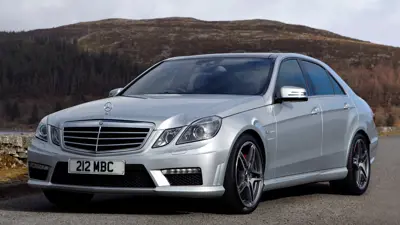
E Class (2009 – 2016)
The Mercedes E-Class is a large saloon car that's comfortable, luxurious and spacious
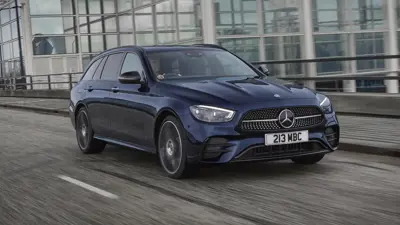
E Class Estate (2016)
Space, luxury, cutting edge tech and a smooth ride: the Mercedes E-Class does it all - but it comes at a price
.jpg?width=400&height=225&format=webp)
E Class All-Terrain (2017 – 2020)
A car designed specifically for owners who need the flexibility to cope with urban, highway and rural driving.

